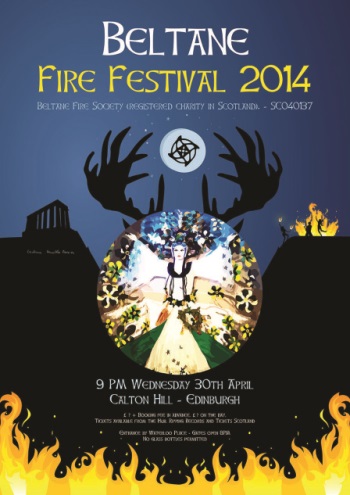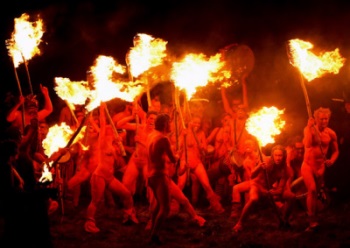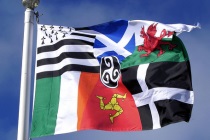The Druids of Calton Hill - The Edinburgh Beltane Fire festival
Continuing our reprise of articles on Beltane - Originally posted April 27, 2014 by Emmett McIntyre. The 2015 Festival begins tonight, 30 April, at 8:30 in Edinburgh :
Transceltic are honoured to have had the opportunity to interview Matthew Richardson, former Chair of the Beltane Fire Society and spokesman for the 2014 Festival. Richardson joined the festival as a student at the University of Edinburgh 16 years ago and brings a unique insight into Celtic roots and Druidical traditions that have flourished since the Festival’s founding over 25 years ago.
The Beltane Fire Festival follows some of the core Celtic traditions ... (and) features key events and characters from Celtic Mythology. Many aspects...were originally inspired by the role of the Druid in Celtic society...and mirror the roles that would have been played in the Druidical tradition. The Neid fire (Beltane Bonfire) is very important to us, being one of the oldest traditions of Beltane that is known.
The Beltane Fire Festival to be held at Edinburgh’s Calton Hill is the premiere event celebrating the Celtic Festival of Beltane. The international prestige of Beltane Fire festival grows stronger every year. The Beltane Fire festival was first held in 1988 and has developed its own traditions built on the legacy of 2,500 years of Beltane observances. The Beltane Fire Society is a Community Arts Performance Charity that hosts the Beltane Fire Festival as well as Halloween's Samhuinn (Samhain) Fire Festival. The Beltane Fire Society Festival also celebrate the Celtic Cross-Quarter days of Imbolc and Lughnasadh as well as Solstices and Equinoxes.

Depiction of Beltane Fire Festival. Courtesy of Beltane Fire Society website beltanefirefestival.wordpress.com.
Unique amongst the Four Celtic Feast days, Beltane observances have survived in essentially archaic form due in part to its simplicity in that the celebrations historically included the lighting of bonfires. Elements of the tradition have survived into modern times throughout the Six Nations with remnants of the ancient customs surviving into the 20th century in Ireland, Cornwall, Scotland and the Isle of Man (MacKillop). As the Pan-Celtic movement continues to strengthen, Beltane is experiencing resurgence.
The Edinburgh Beltane Fire festival begins with the lighting of the Neid fire which illuminates the route followed by the May Queen around the hill and which eventually provides the flame for the bonfire. The May Queen is accompanied by the Winter King as she arrives at the Acropolis atop Edinburgh’s Calton Hill with her Guardian Handmaidens and Dummers. The Queen’s entourage are interrupted by the Red Men, Spirits of Chaos and Pandemonium, whose efforts are devoted to distracting the Queen as she journey’s downhill. The Winter King is killed and then resurrected as the Green Man who symbolises fertility and sexual license. The Queen then lights the Bonfire from the Neid fire source, which symbolises the light and heat of the coming summer.
Matthew Richardson is the former Chair of the Beltane Fire Society and spokesman for the 2014 Beltane Fire Festival. Matthew is with the University of Edinburgh where he is a Manager of the University’s Apiary Project which is dedicated to the preservation and propagation of the Honey Bee. Mr. Richardson enjoys a unique insight in to evolving traditions of the festival, having been an active participant for 16 years.
Interview with Matthew Richardson, spokesman for the Beltane Fire Festival 2014
1. Tell us about the Celtic traditions on which the Beltane Fire Festival is based.

Poster for Beltane Fire Festival 2014, which is being held on Wednesday 30th April at 9pm on Carlton Hill in Edinburgh, Scotland.
The Beltane Fire Festival follows some of the core Celtic traditions, and features some of the key events and characters form Celtic mythology, including the Neid Fire, Beltane Bonfire and the May Queen/Green Man. However our festival equally features new aspects and characters, drawn from other customs and traditions around the world, as well as some of our own unique customs and characters, which have developed over the last 25 years of running the festival.
2. The Blue Men are described on the Festival’s web page as keepers of “Beltane Lore”. Can you tell us more about the Blue Men? Keeper’s of Lore was, generally speaking, the role of the Druid in Celtic society as the Druidical tradition banned the writing down of knowledge and ritual practices. Is there an awareness amongst the Blue Men of the similarity between the role they play and that played by Druids in pre-Christian Celtic culture?
Many aspects of the Blues in our Beltane was originally inspired by the role of Druid in Celtic society, and many of the aspects of the Bluerole mirror the roles that would have been performed in the Druidical tradition - the passing on of stories and traditions (usually orally, rather than written down), helping to coordinate and advise on the rituals and route of the festival (both the event, and the preparation for it) and supporting the court on their journey. The role of the Blues has changed over the years, from initially being a purely performance role, to one more involved in the rituals and traditions of the event, depending on the needs of the festival and the society.
3. Central to the Beltane ritual is the journey of the May Queen, who represents the fertility of spring, and her consort, the Green Man, through the celebrants to conclusion of the procession. Can you share with us how the May Queen and Green Man are selected?
The May Queen character is selected from existing members of the society to hold the role for a number of years, until that individual feels that they wish to move on from the role. As such we have only had 6 May Queens over the last 25 years. Usually the May Queen is someone who has been involved in a number of festivals (often in a role associated with the May Queen, such as the White Women), and is known to the majority of members of the society. Selection is done by the current May Queen, with assistance from the Blues, with final say falling to the Beltane board.
The Green Man is usually selected 'fresh' each Beltane, and unlike the May Queen, is not always someone known to the society - in some years the Green Man has been a completely new introduction to the festival. The Green Man is selected from interviews by the May Queen and Blues with prospective candidates, and is chosen based on their own interpretation of the role for the current festival, and seeing how it fits in with the larger aims of the May Queen and the society for that year.
4. The villains of the Beltane festival are the Red Men who attempt to impede then journey of the May Queen and the Green Man. Tell us about the role the Red Men play at the Beltane Fire Festival.

The Red Men are perhaps best thought of as aspects of the chaos of nature and the universe - not malicious or consciously interfering with the journey of the procession, but instead getting in the way with their curiosity and inquisitiveness. Drawn to the May Queen and Green Man like moths to a flame, they interact with the raw energy of the procession, but their advances are initially repelled. Only later, when they see the death and rebirth of the Green Man, do they become tied to the 'here and now' and become less chaotic and more tamed, allowing a fuller interaction with the other characters.
5. Describe the logistics that go in to the lighting of the festival fires.
The Neid fire and bonfire tradition is very important to us, being one of the oldest traditions of Beltane that is known. At the start of our festival, we use a traditional bow drill to create an ember and start a fire, which we then use to light all the torches which are carried by the torch-bearers who accompany the procession. This fire then travels round the hill, lighting other points along the way, until the procession reaches the bonfire. Here the May Queen takes the fire and uses it to light the bonfire, moving around the fire in a symbolic cleansing. The warmth, light and smoke from the fire serves to cleanse and purify those on the hill, as was traditional for the members of the community and their livestock at Beltanes across the UK. All fire on the hill is thus lit from the initial Neid fire, in the tradition of the original Beltanes, where fire would be taken from the Neid fire to relight the fires in the hearths of the community.
https://beltanefiresociety.wordpress.com/beltane-fire-festival-2015-2/
Beltane Fire Society is a not-for-profit registered charity in Scotland.
Charity Number: SC040137
Company Number SC341753.
- Emmett McIntyre's blog
- Log in to post comments






